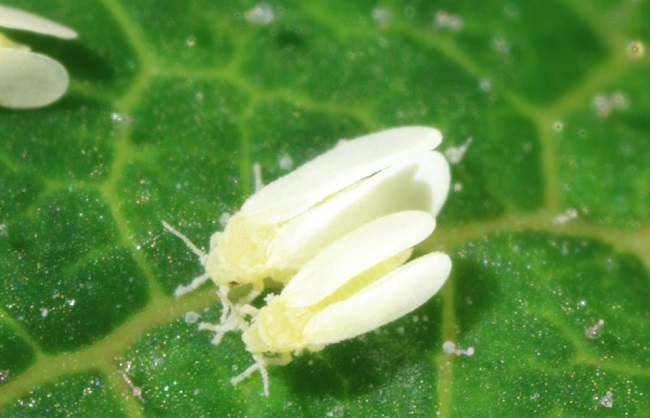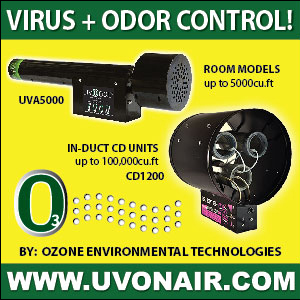Few things are as disheartening to a greenhouse grower as discovering an insect infestation. Pest insects not only disrupt the beauty and Zen-like atmosphere found in our greenhouses, but they can also destroy a multitude of plants in a very short amount of time. Prevention is the best way to avoid potential devastation but, unfortunately, that is not always possible. In order to negate the damage these tiny critters could impose, a greenhouse grower must learn how to properly identify a problem and implement a treatment program specific to the pest’s life cycle before things get out of hand. In other words, early detection is crucial.

General Prevention
First and foremost, regarding prevention is eliminating or reducing the possibility of pest insects entering the greenhouse. The number one-way pest insects enter a greenhouse environment is by the gardeners themselves. Each time you purchase or acquire a new plant specimen it is a good idea to not only inspect it for bugs but also place it in an area outside your greenhouse for a few days to “quarantine” it before introduction. If there are any signs of insects or you are unsure about the cleanliness of your newly acquired plant do not introduce it into your greenhouse. Sure, this may be the rare African violet you feel completes your collection but remember it could also be the one that completely destroys it. It’s good idea to get into the habit of treating any new plant with a general-purpose insecticide when quarantining it. After a few days, if it passes inspection, introduce the new specimen into your greenhouse.
Many pest insects will enter a greenhouse by hitching a ride on an unsuspecting gardener or pet. If possible, avoid entering your greenhouse right after doing yard work or other outdoor activities that would expose you to any of the pest insects in your area. Pets that roam freely outdoors should be brushed or bathed before they enter your greenhouse to reduce the chance of pest insect stowaways.
A fine screen or mesh that covers the ventilation openings of a greenhouse will greatly reduce the chance of pest insects entering. Check your greenhouse material for small cracks or holes, then caulk and seal if necessary. Sometimes even the most seemingly minor repairs can make major differences in pest prevention.
Another simple measure any greenhouse grower can take to prevent unwanted pests is to keep a clean growing environment. Dead leaves, discarded soil, standing water, and previously used planting containers are places for pest insects to live and breed. A clean growing environment is beneficial in many regards but especially in terms of pest control. Besides, nothing is more relaxing than spending time in a freshly cleaned greenhouse surrounded by fragrance and beauty. This is an excellent article on how to complete a deep cleaning of your greenhouse.
Pest Identification and Specific Treatments
No matter how clean you keep your greenhouse or how hard you try to eliminate unwanted visitors, chances are, at some point, you will have to deal with a pest insect infestation. There is a wide array of insects that feed exclusively on plant material, some of which are more commonly found in greenhouses than others. In outdoor environments predatory insects and birds that feed on the pest insects are the way nature finds its balance. In some cases, plants will produce pheromones that attract predatory insects to help eliminate the parasitic insects. Within our greenhouses, however, nature’s balance is disrupted. This gives the gardener more control over environmental conditions but also gives pests the opportunity for a free lunch.
Early detection and proper identification are crucial to nip the problem in the bud. The reason early detection is so important is because most pest insects have fast gestation periods. These fast gestation periods teamed with large birth numbers are the reasons uncontrolled pest insects can take out an otherwise healthy greenhouse in a matter of days. Most pest insects have “giveaway” signs that can help to identify them. If you are unsure of the species of insect affecting your garden try to capture a few of the insects (sticky traps or a piece of clear packing tape work well) and then look at reference books, view garden pests online, or take them to your local garden center to be properly identified. Make sure the insects are dead before you take them to any garden store. Garden supply stores and nurseries won’t appreciate it if you bring in live pest insects.
To treat the pest insects in their greenhouses some gardeners prefer spraying or applying insecticides. It is extremely important to always spray a small portion of each plant variety to “test” the insecticide before treating your entire greenhouse. Certain plants may have a heightened sensitivity to insecticides which means you could unknowingly cause more damage than the pest insect themselves. This phenomenon is not only relevant to chemical insecticides. Japanese maple, for example, is very sensitive to neem oil (an otherwise harmless yet effective insecticide). It is also known that portulaca, plum, cherries, sweet pea, hawthorn, and some tomato varieties can be adversely affected by insecticidal soap treatments. Some gardeners choose to avoid insecticides altogether and introduce beneficial insects to “naturally” control a pest insect problem. This is a great approach because insects can quickly become resistant to insecticides but have a hard time building a resistance to being eaten.
Common Greenhouse Pest Insects and Treatments
Aphids
Identification
Aphids are small, pear-shaped insects usually found in dense clusters on the undersides of leaves and/or on the tender new growth tips. Plants with aphid infestations appear wilted or generally unhealthy. There are many different varieties of aphids that range in size and in color (green, brown, yellow, pink, or black).
Treatment
Any insecticide specific for soft-bodied insects will work well for aphids. Insecticidal soap and neem oil are my preferred treatments for this little monster.
Beneficial Insect Control
Ladybugs (Hippodamia Convergens), Aphid Predators (Aphidoletes Aphidimyza), Aphid Parasites (Aphidius Matricariae), Green Lacewings (Chrysoperla Rufilabris)
Whiteflies
Identification
Whiteflies look like tiny white moths and are easy to identify because they fly around when the foliage is disturbed. Another telltale sign is the shiny sheen they leave behind on the leaves. Whiteflies are more of an annoyance than a detrimental problem. However, if left untreated a large population of whiteflies will leave enough residue on the leaves of the plants that it will eventually develop into a black pathogenic mold.
Treatment
Yellow colored sticky traps work wonders for catching the adult whiteflies. It is best to combine the sticky traps with some sort of insecticide specific for soft-bodied insects to treat the eggs and larvae.
Beneficial Insect Control
Whitefly Parasites (Encarsia Formosa), Whitefly Predators (Delphastus Pusillus), Green Lacewings
Mealybugs
Identification
Mealybugs can be identified by cotton-like fluffy masses found in crotches or joints. These “cotton balls” are clusters of the slow moving mealybugs. These buggers are slow to reproduce but should still be treated immediately after positive identification.
Treatment
General insecticides that are specific to soft-bodied insects work for mealybugs if you are diligent. It is recommended to continue treatment for weeks after the last sign of mealybugs is seen. These bugs tend to reappear weeks, if not months, after you think you have eradicated the problem. Physical removal of the cotton-like clusters with a cloth or by hand (prior to foliar treatments) is also recommended.
Beneficial Insect Control
Mealybug Destroyers (Cryptolaemus Montrouzieri), Pirate Bugs (Orius Insidiosis), Ladybugs, Green Lacewings
Thrips
Identification
The most identifiable stage of the thrip’s life cycle is the larvae stage. Thrip larvae feed on leaf surfaces and generally leave a shiny trail which illuminates their previous feeding paths. They will also leave tiny black specs (fecal matter) on the leaf surface as they feed. The larvae resemble a fast-moving grain of rice and can come in a variety of different colors but are usually yellowish-green.
Treatment
A multifaceted approach is required to control thrips because they live a portion of their life cycle on the plant and the other portion is lived in the soil or medium. The best way to eradicate a thrip infestation is to combine blue sticky traps for the flying adults with both an insecticide specific for soft-bodied insects for the larvae and eggs on the plant surface and a soil drench insecticide for the larvae found in the soil or medium.
Beneficial Insect Control
Pirate Bugs, Ladybugs, Green Lacewings, Predatory Nematodes (larvae in soil)
Spider Mites
Identification
Yellow speckling that almost appears like a lightly misted yellow spray paint is the sign of spider mites feeding. In more extreme infestations a webbing will be found in-between or on the tips of branches and leaves. This webbing looks like a spider web and is how these nasty creatures received their fitting name.
Treatment
As with mealybugs, diligence is key to eliminating a spider mite problem. Miticides (insecticides created specifically for mites) are generally the best option for treatment. Make sure to continually treat your garden every 3-4 days for at least a month period. This is to catch any new spider mites that may hatch (hatching occurs every 3-4 days). Although some miticides claim to destroy the eggs, spider mite eggs are extremely persistent and seem to hatch no matter what you spray on them.
Beneficial Insect Control
Spider Mite Predators (Phytoseiulus Persimilis, Neoseiulus Californicus, Mesoseiulus Longipes), Spider Mite Destroyers (Stethorus punctillum), Predatory Midge (Feltiella Acarisuga)
Fungus Gnats
Identification
Small mosquito-looking black or gray insects that aimlessly fly around the greenhouse especially right after you water or disturb the soil. Fungus gnat larvae appear like tiny light-colored worms that move around in the top layer of soil.
Treatment
Blue or yellow sticky traps are equally effective for fungus gnat adults. Soil drench insecticides can be used to treat the eggs and larvae found in the soil. A simple solution is to start watering plant containers from the bottom which causes the top layer of soil to dry out. Fungus gnats require moisture in the top few inches of soil to complete their life cycle.
Beneficial Insect Control
Fungus Gnat Predators (Hypoaspis sp.), Ladybugs, Pirate Bugs, Predatory Nematodes (larvae and eggs in soil)
Pest insect problems, as annoying as they are, can be great opportunities for greenhouse owners to expand their knowledge and try new products and/or techniques. Eradicating an insect infestation will also give a gardener a sense of accomplishment and possibly a greater appreciation for the ongoing beauty found in their greenhouse. Dealing with pest insects is just one of the many hurdles a greenhouse grower will have to jump during their quest to create their own ultimate horticultural experience.
Eric Hopper resides in Michigan’s beautiful Upper Peninsula where he enjoys gardening and pursuing sustainability.
Related Articles & Free Email Newsletter Sign Up
How Organic Pesticides and Beneficial Insects Can Combine to Eliminate Pests
How to Identify the Pest You are Dealing With
Natural on the Label Doesn’t Always Mean Safe



Comment here